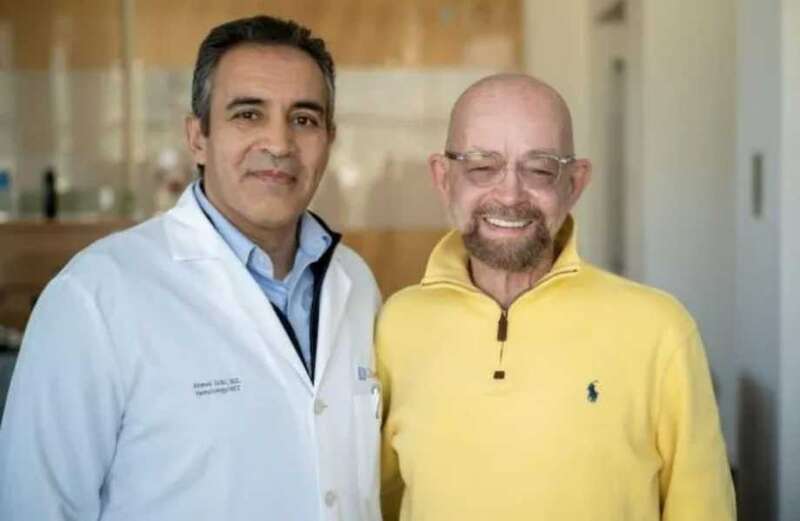A MAN was "cured" of HIV and leukaemia after a "remarkable" stem cell transplant from a donor with a rare genetic mutation.
Paul Edmonds, 67, was diagnosed with AIDS in 1988.


After living with the condition for 30 years, he was diagnosed myelodysplastic syndrome in 2018, which eventually developed into acute myeloid leukaemia (AML).
This is common in older people with HIV - the cause of AIDS - as their weakened immune system makes them vulnerable to developing leukaemia and other blood cancers.
Paul never imagined he'd be free of the disease.
 Hospitals run out of oxygen and mortuaries full amid NHS chaos
Hospitals run out of oxygen and mortuaries full amid NHS chaos
But since receiving a groundbreaking stem cell transplant at the City of Hope cancer treatment and research centre in California in 2019, Paul has been in remission from the killer condition for five years.
In another two years, he could be considered 'cured' of HIV, as that will mark five years from his last treatment for the condition.
To celebrate, the medical team behind his astonishing recovery has published a letter describing his treatment in the New England Journal of Medicine.
When the medical breakthrough was first announced in July 2022, Paul wished to remain anonymous and was nicknamed 'the City of Hope patient'.
But he's now chosen to speak out about his story.
He's the fifth person to be cured of HIV and the oldest to go into long-term remission.
Paul, from Desert Hot Springs, California, said: “A big reason I want to tell my story is to bring some hope for people with HIV.
“And I want to remember all those we lost.”
'Donor saved my life'
Paul lived with HIV for 31 years before receiving the groundbreaking transplant.
He'd been on HIV antiretroviral therapy since 1997, which suppressed the virus to undetectable levels.
 Mystic Mag's 2023 predictions include strikes, sleaze, self pity and separation
Mystic Mag's 2023 predictions include strikes, sleaze, self pity and separation
But antiretroviral therapy doesn't cure HIV, so the virus's DNA still lingered in the immune cells in his blood.
As people with HIV live longer, there's an increased risk of them developing cancer, Jana K. Dickter, associate clinical professor with City of Hope’s division of infectious diseases, explained.
"The idea that you can treat their malignancy and their HIV at the same time is pretty amazing," she said.
This was the case with Paul, who started treatment for leukaemia in 2018.
Ahmed M. Aribi, assistant professor with City of Hope’s Division of Leukemia who was involved in Paul's care, let him know that he'd need a stem cell transplant to beat the cancer.
But Paul's medical team decided to search for a donor who carried a rare HIV-resistant genetic mutation, in the hopes of curing him of AIDS too.
Called the homozygous CCR5 delta 32 mutation, it makes people resistant to most strains of HIV infection.
As transplant patients must first drive their cancer into remission, Paul underwent three gruelling rounds of chemotherapy before he was able to attempt the treatment.
He also did another week of pre-transplant chemo to completely wipe out his immune system and prepare his body to receive healthy stem cells.
Meanwhile, City of Hope's donor department trawled through millions of donors in the Be The Match bone marrow registry and identified two possible matches.
One of them agreed to donate to Paul.
When he was told they'd had found a donor with the rare genetic mutation, Paul said: “I felt like I won the lottery."
Only one to two per cent of the world’s population carry the mutation, according to City of Hope.
Then 63, Paul finally received stem cells from his donor on February 26, 2019.
“Transplant was a breeze,” said Paul, especially compared to other treatments he's had to undergo before it.
“I started feeling pretty good almost immediately and just continued to feel really good.
“I'm very thankful for that wonderful person who donated those stem cells.
“I can’t thank him enough for what he did. He saved my life.”
No trace of HIV
City of Hope doctors monitored Paul after his transplant and planned to wean him off antiretroviral therapies for HIV in March 2020.
With the Covid-19 pandemic throwing a spanner in the works, this was delayed until March the following year.
Paul continued having his HIV levels checked and, each time, no virus could be detected.
Dr Dickter said: “We did even further testing to see if we could find the virus hiding in the reservoir while he was off his antiretroviral medications, and again, everything came back effectively negative."
Paul has also shown no signs of leukaemia since his treatment.
Now almost three years off his HIV meds, Dr Dickter said she was "thrilled for him".
In the letter published to the New England Journal of Medicine, doctors wrote: "At the time of this follow-up, the patient had been free of HIV-1 infection for 35 months after the discontinuation of antiretroviral therapy.
"This case has shown that older patients who are undergoing reduced-intensity conditioning HCT for the treatment of cancer may be cured of HIV-1 infection."
Dr Dickter said: “It’s incredible to think that when I was a fellow so many years ago, the idea of having someone effectively cured of their HIV seemed almost impossible, or something that I would never see or experience firsthand.
“We've come such a long way. We now have so many tools for people with HIV that are effective and well-tolerated."
Stem cell transplants do come with substantial risks, so not all people living with HIV will be able to receive this treatment.
It's still only viable for people with life-threatening blood cancers like Paul.




































